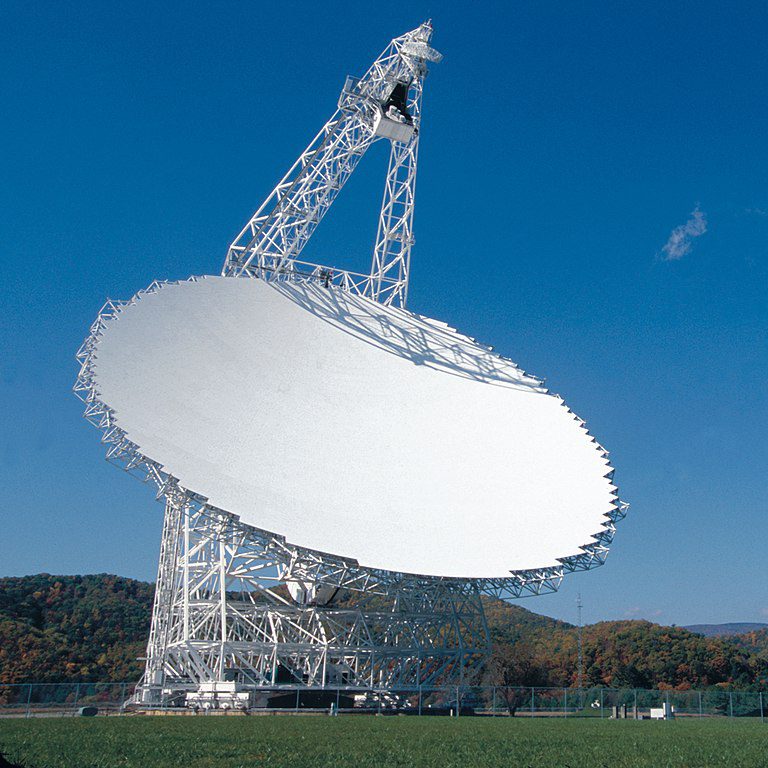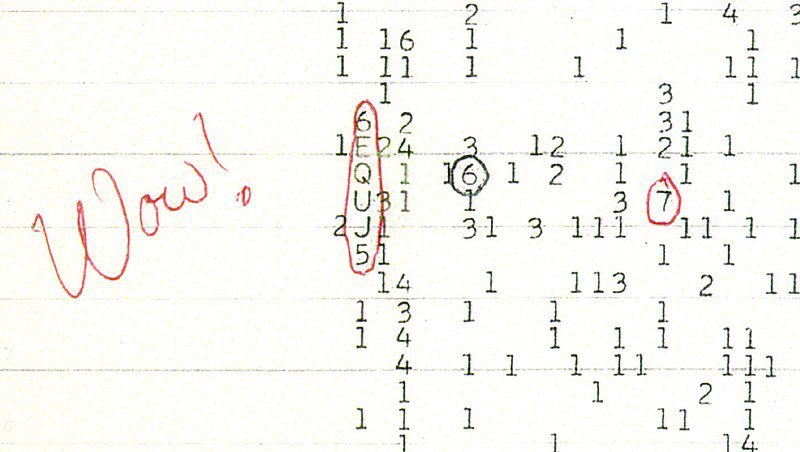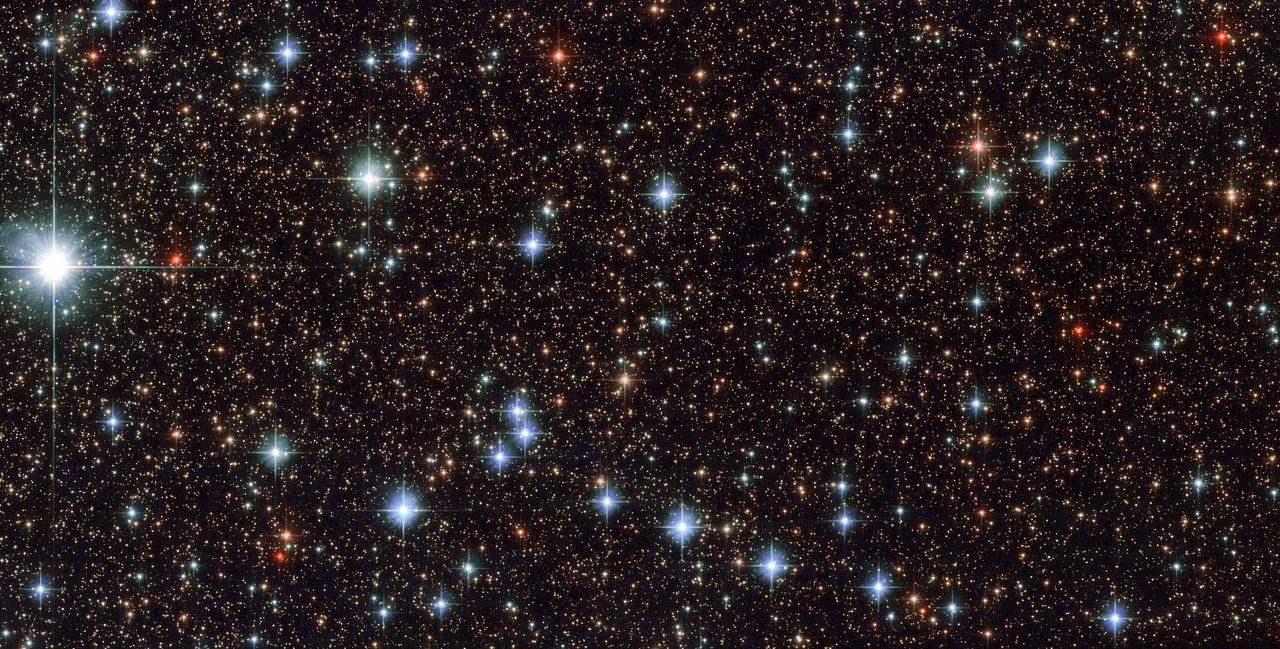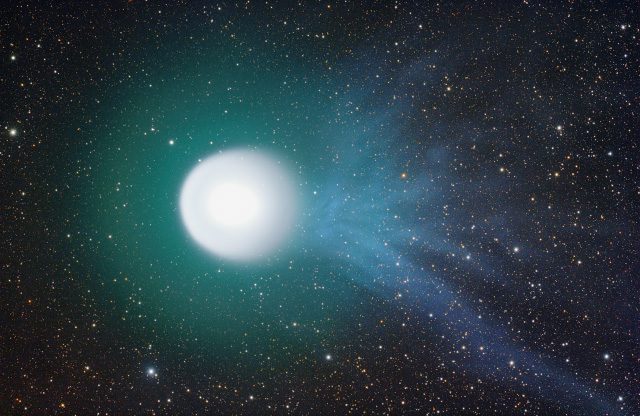For 72 seconds on August 15, 1977, a radio telescope in Ohio detected what may have been a signal from extraterrestrial intelligence. It was a narrow-band burst of radio waves, matching no known natural phenomenon, and it stood out like a sore thumb from the ordinary background noise of the cosmos. The astronomer on duty jotted down one word on the data printout: “Wow!”
What was the source of this signal? Was it a natural phenomenon in deep space—or perhaps, the first evidence of life beyond our Solar System? Read on to discover the mysteries of the Wow! signal, an enduring enigma that stumps scientists to this day.
SETI: Eavesdropping on alien radio signals
The search for extraterrestrial intelligence (SETI) began in the early 1960s, with the pioneering work of Frank Drake and other astronomers. Since then, it has expanded into a worldwide scientific effort, coordinated by the nonprofit SETI Institute. Sadly, their work does not yet entail flying out into deep space in search of new life and new civilizations; with the stars out of reach, at least for now, the best we can do is scan the sky with radio telescopes, and see if we can pick up traces of civilizations elsewhere in the cosmos.

It’s grueling work, offering the dim prospect of success in exchange for virtually infinite patience. As thankless a task as it may be, though, the payoff would be of existential significance: an answer to the question of whether we’re alone in the universe. Many scientists have made just that bargain. To date, SETI has not succeeded in its mission—we have, of course, no positive confirmation of alien intelligence, or even if any extraterrestrial intelligence would be friendly—but in 1977 we did get a promising lead, when the Big Ear Radio Observatory detected the Wow! signal.
The Big Ear Radio Observatory
Big Ear, known officially as the Ohio State University Radio Observatory, operated on the grounds of Ohio Wesleyan University between 1963 and 1998. At the time, it was one of the most sensitive radio telescopes in operation. It used two reflectors: a flat 340-foot by 100-foot (104 m by 30 m) tiltable reflector, and a stationary 360-foot by 70-foot (110 m by 21 m) parabolic mirror. Both were made of wire mesh, spaced tightly enough to be opaque to radio waves. When waves came down from the sky, they bounced off the flat reflector and towards the parabolic reflector, which in turn directed the focused signals into two “feed horns,” containing scientific instruments that measured and recorded the data.

This was nothing like a telescope you might set up in your backyard. It was a vast, unsightly installation, designed to capture faint sources with its enormous aperture, and instead of swiveling up or down, it relied on the rotation of the Earth to slowly scan the sky. The geometry of the reflectors meant that each feed horn was looking in a slightly different direction. Ideally, an object of interest would appear first in one horn, then the other.
The Big Ear telescope was assigned to SETI observations in 1973, after it had completed its main work of surveying deep-sky radio sources. A few years later, in 1977, astronomer Jerry Ehman worked there as a volunteer, combing through reams of data in the hope of identifying something useful. One can only imagine how tedious this was; the odds of Big Ear picking up an interesting signal were vanishingly remote, but he had to read every single computer printout, just to make sure.
Wow!
On August 15, at 10:16 PM, the Big Ear telescope detected a radio signal that appeared on the computer printout as a six-digit alphanumeric code—6EQUJ5. When Ehman read this, it came as such a surprise that he immediately took out a red pen and circled the sequence, then jotted down an enthusiastic “Wow!” on the margin. Hence, the Wow! signal.

But what was so interesting about that random jumble of letters and numbers? It would certainly seem uninspiring, for humanity’s first message from E.T—except that 6EQUJ5 was not the content of the signal, but a representation of its intensity. The Big Ear radio telescope used a somewhat idiosyncratic method to measure this. Signal intensity was expressed in terms of standard deviations from the mean, which is to say, how extreme it was compared to the normal background noise from distant stars. The scale ran initially from 1 to 9, and higher readings went from A to Z. Each digit represented the average intensity for a ten-second interval.
You’ll note that in the above picture, most of the numbers are ones and twos. There are a few higher numbers—a six and a seven, both circled as objects of interest—and then, on the left edge, we see a reading so high it goes off the numerical scale and all the way to the far end of the alphabet. For perspective, 99.7% of the values in a normal distribution (bell curve) fall within three standard deviations; the peak of the Wow! signal, “U,” was thirty standard deviations from the mean.
Wow, indeed!
Attempted follow-ups
The Wow! signal came from the constellation Sagittarius. While there remains some uncertainty about its precise location—the Big Ear telescope’s two feed horns pointed in slightly different directions, and the computer did not record which one picked up the signal—Jerry Ehman and other astronomers were able to narrow down its origin to within less than a degree of sky. They made over fifty attempts to eavesdrop on this region, hoping for a repeat. Surely there would be something to prove that it wasn’t just a fluke. But as successive efforts used more and more powerful radio telescopes, all the way up to the mammoth Very Large Array in New Mexico, they were rewarded for their efforts with silence. The Wow! signal remained a one-off, and whatever sent it has been quiet ever since.

Some more oddities
Without any successful follow-ups, all astronomers had to work with was the single, brief snippet of data detected by the Big Ear radio observatory. The question of its origin has inspired vigorous debate. There are a number of unusual circumstances surrounding it, which complicate the discussion. For instance, the Wow! signal was visible only for a 72-second window, while Big Ear passed over its section of sky, and during that time, there was no observed frequency modulation, which would imply that the signal was meaningless—just a flat, unvarying tone broadcast into the galaxy. It is also possible, however, that the modulation was outside the scope of the instrument. A very long modulation period, greater than 72 seconds, would never have been detected in the first place.
The frequency of the Wow! signal is also a puzzle. In 1959, physicists Philip Morrison and Giuseppe Cocconi predicted that advanced civilizations would communicate using energy emissions from hydrogen atoms, which always produce waves with a frequency of 1,420.4058 megahertz. According to Ehman’s calculations, the Wow! signal was extremely close to that figure, at 1,420.4556 megahertz. What explains the gap? Well, due to the Doppler effect, radio signals vary in frequency depending on the velocity of their source relative to an observer; the same principle can be observed in jet engines and ambulance sirens. Assuming the Wow! signal was based on the spectral line of hydrogen, its source would have been traveling at a relatively modest 6.2 miles per second (10 km/s) toward Earth.
Natural or artificial?
But what was it? Scientists of the skeptical sort have floated various natural or terrestrial explanations, none of which have satisfied the SETI community. Some researchers, including Ehman himself, have suggested that it was an ordinary human broadcast bouncing off a piece of space junk; Ehman later rejected this view, determining that no debris of reasonable size could have created the signal he’d seen.

In 2017, Florida professor Antonio Paris proposed a new explanation: the Wow! signal came from one of two comets, 266P/Christensen and P/2008 Y2 (Gibbs), that happened to be in Big Ear’s field of view when the observation took place. A hydrogen cloud trailing behind the comet would have given off radio emissions in the range of 1,420 megahertz. This theory received considerable attention at the time, but it did not hold up to scrutiny; while the suggested comets were close to the observed location, they were not close enough, nor is there any known mechanism by which a comet tail can produce such a strong signal.
That seems to leave two culprits: either a natural phenomenon we don’t know about, or genuine alien intelligence. Whatever it is, the Wow! signal seems to have ended, given that 50 follow-up attempts in the same region turned up nothing. It may have switched off; it may have pointed elsewhere, sweeping across space like the beam of a cosmic lighthouse. Or maybe it was an alien equivalent of our Arecibo message, broadcast in our general direction for the benefit of any waiting civilizations—and we just missed what it was trying to say.
Unanswered questions
The Wow! signal promised to be the Holy Grail for the SETI project—direct evidence of an intelligent civilization elsewhere in the cosmos. In reality, however, it only left astronomers scratching their heads. It was remarkable enough to catch our attention, but too short to allow for any follow-up study. Even now, it is an unsolved mystery, and its most exciting explanation—that aliens sent it—remains entirely on the table. If only it had remained in view for a little longer, we might have known for sure. For now, though, we’ll have to keep waiting, and listening.


